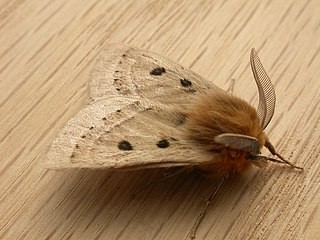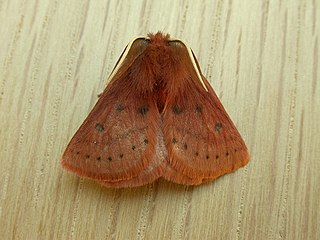Related Research Articles

An inflorescence is a group or cluster of flowers arranged on a stem that is composed of a main branch or a complicated arrangement of branches. Morphologically, it is the modified part of the shoot of seed plants where flowers are formed on the axis of a plant. The modifications can involve the length and the nature of the internodes and the phyllotaxis, as well as variations in the proportions, compressions, swellings, adnations, connations and reduction of main and secondary axes. One can also define an inflorescence as the reproductive portion of a plant that bears a cluster of flowers in a specific pattern.
Amphictyonis in Greek mythology is a goddess of wine and friendship between nations, a local form of Demeter. Demeter was worshiped under this name at Anthela, because it was a meeting place for the amphictyons of Thermopylae, who offered sacrifices to her at the start of every meeting.

Anthela ocellata, the eyespot anthelid, is a moth of the family Anthelidae. The species was first described by Francis Walker in 1855. It is found in Australia, from Bundaberg to Hobart along the east coast.

Anthela ferruginosa is a species of moth of the family Anthelidae. It is found in Australia.

Anthela nicothoe, the urticating anthelid, is a moth of the family Anthelidae.

Anthela is a genus of moths of the family Anthelidae. The genus was erected by Francis Walker in 1855.
Anthela angiana is a moth of the Anthelidae family. It is found in New Guinea.
Anthela binotata is a moth of the Anthelidae family. The type location is Peak Down.
Anthela brunneilinea is a moth of the Anthelidae family. It is found on the Kei Islands.
Anthela charon is a moth of the Anthelidae family. It is found in New Guinea.
Anthela ekeikei is a moth of the Anthelidae family. It is found in New Guinea
Anthela inconstans is a moth of the Anthelidae family. It is found in New Guinea.
Anthela limonea is a moth of the Anthelidae family. It is found in Australia.
Anthela lineosa is a moth of the Anthelidae family.
Anthela odontogrammata is a moth of the Anthelidae family. It is found in New Guinea.
Anthela roberi is a moth of the Anthelidae family. It is found in New Guinea.
Anthela rubriscripta is a moth of the family Anthelidae first described by Thomas Pennington Lucas in 1891. It is found in Australia.
Pseudodreata aroa is a moth of the Anthelidae family. It was described by George Thomas Bethune-Baker in 1904. It is found in New Guinea.
Anthela or Anthele was a town and polis (city-state) of Malis in Ancient Thessaly. Herodotus places the town between the small river Phoenix and Thermopylae which was a celebrated pass between Thessaly and Phocis. He also mentions that the Thessalian Asopus river passed through its surroundings and that there was a sanctuary of Demeter, a place where the Amphictyonic League celebrated its meetings and a temple of Amphictyon. According to legend, the league was founded, in part, to protect the temple of Demeter at Anthela. Anthela is in the immediate vicinity of the pass of Thermopylae, celebrated for the temples of Amphictyon and of the Amphictyonic Demeter, containing seats for the members of the Amphicytonic council, who held here their autumnal meetings. At Anthela, Mount Oeta recedes a little from the sea, leaving a plain a little more than half a mile in breadth, but again contracts near Alpeni, the first town of the Locrians, where the space is again only sufficient for a single carriage. Modern scholars identify its location with the modern village of Anthili in the municipality of Lamia.
References
- ↑ Beccaloni, G.; Scoble, M.; Kitching, I.; Simonsen, T.; Robinson, G.; Pitkin, B.; Hine, A.; Lyal, C., eds. (2003). "Anthela trisecta". The Global Lepidoptera Names Index . Natural History Museum.
- ↑ Proceedings of the Royal Society of Queensland
 This article incorporates text from this source, which is in the public domain .
This article incorporates text from this source, which is in the public domain .